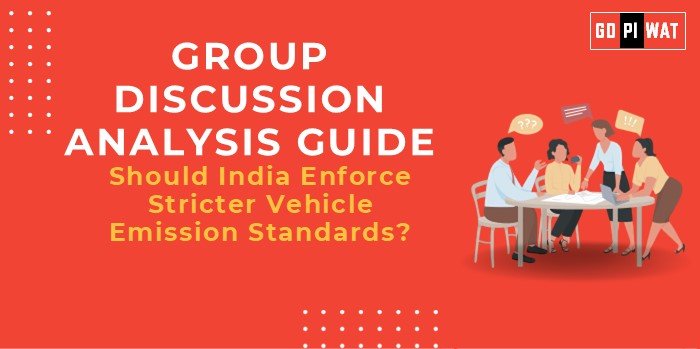📋 Group Discussion Analysis Guide: Should India Enforce Stricter Vehicle Emission Standards?
💡 Introduction to the Topic
- 📖 Opening Context: India, with its rapidly urbanizing population and growing vehicle ownership, faces a pressing challenge to combat air pollution, which is a leading environmental and public health crisis. Vehicle emissions contribute significantly to urban air pollution, making stricter emission standards essential for sustainability.
- 📜 Topic Background: India introduced the Bharat Stage Emission Standards (BS), aligning with global trends to reduce vehicular pollution. With the transition to BS-VI in 2020, India’s emission norms advanced, but enforcement remains inconsistent. Tightening standards further can aid in achieving environmental goals like reduced carbon footprint and improved public health, aligning with commitments under the Paris Agreement.
📊 Quick Facts and Key Statistics
- 💀 Air Pollution Fatalities: 1.67 million deaths annually in India due to air pollution (Lancet, 2022).
- 🚗 Transport Emissions Contribution: Accounts for 11% of India’s total CO₂ emissions, with road transport being a major contributor (IEA, 2023).
- 💰 BS-VI Transition Cost: Automakers invested ₹60,000 crores for BS-VI compliance, showing industry’s commitment to innovation.
- 🌍 Global Benchmark: Countries like Norway have announced bans on internal combustion engines by 2025, signaling the global trend.
🌟 Stakeholders and Their Roles
- 🏛️ Government: Establishing policies, monitoring compliance, and promoting public transportation.
- 🏢 Automobile Industry: Innovating cleaner technologies and ensuring compliance.
- 👥 Citizens: Adopting greener vehicles and reducing private vehicle use.
- 🌿 Environmental Organizations: Advocating for stricter laws and public awareness campaigns.
📈 Achievements and Challenges
🏆 Achievements
- ✅ Successful Implementation: Nationwide rollout of BS-VI standards in 2020.
- ✅ EV Market Growth: Rapid expansion supported by incentives like FAME-II.
- ✅ Cleaner Fuels: Availability in major cities.
⚠️ Challenges
- 🚧 Infrastructure: Insufficient charging stations and testing facilities.
- 🚧 Cost Barriers: Higher vehicle costs due to compliance technology.
- 🚧 Regulatory Gaps: Weak enforcement of emission norms, especially in smaller cities.
🌍 Global Comparisons
- 🇨🇳 China: Strict enforcement and EV subsidies helped reduce vehicular emissions by 11% in five years.
- 🇩🇪 Germany: Advanced emission norms with robust testing mechanisms.
📜 Case Study
🚦 Delhi NCR: Successful implementation of Odd-Even vehicle rationing schemes during high-pollution periods.
🗣️ Structured Arguments for Discussion
- 👍 Supporting Stance: “Stricter emission standards will improve air quality and public health, aligning India with global environmental goals.”
- 👎 Opposing Stance: “High compliance costs may stifle automobile industry growth and increase vehicle costs for consumers.”
- ⚖️ Balanced Perspective: “While emission standards are necessary, they must be complemented by robust infrastructure, incentives, and phased implementation.”
💬 Effective Discussion Approaches
- 📈 Opening Approaches:
- Statistical Insight: “Air pollution costs India an estimated 1.36% of its GDP annually, making stricter emission standards vital for economic and public health.”
- Case Study: “Delhi NCR’s Odd-Even rule showcases how effective measures can curb urban air pollution.”
- ⚡ Counter-Argument Handling:
- Use global examples to refute claims of infeasibility.
- Highlight how incentives can offset industry and consumer costs.
📋 Strategic Analysis of Strengths and Weaknesses
- 💪 Strengths: Growing EV industry, strong policy framework like FAME-II.
- ⚡ Weaknesses: Weak enforcement mechanisms, lack of public awareness.
- 🌟 Opportunities: Global leadership in green vehicle technologies.
- ⚠️ Threats: Resistance from industries, rising vehicle ownership rates.
📚 Connecting with B-School Applications
- 🌏 Real-World Applications: Environmental operations management, public policy analysis, and green finance projects.
- 📋 Sample Interview Questions:
- “What policy changes would you propose to reduce vehicular pollution in Indian cities?”
- “How can automakers balance stricter emission norms with profitability?”
- 💡 Insights for B-School Students: Understanding emission policies can aid in strategizing for ESG goals in corporate roles.


